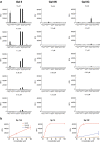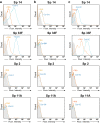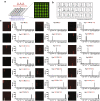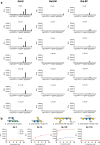Whole microbe arrays accurately predict interactions and overall antimicrobial activity of galectin-8 toward distinct strains of Streptococcus pneumoniae
- PMID: 37005394
- PMCID: PMC10067959
- DOI: 10.1038/s41598-023-27964-y
Whole microbe arrays accurately predict interactions and overall antimicrobial activity of galectin-8 toward distinct strains of Streptococcus pneumoniae
Abstract
Microbial glycan microarrays (MGMs) populated with purified microbial glycans have been used to define the specificity of host immune factors toward microbes in a high throughput manner. However, a limitation of such arrays is that glycan presentation may not fully recapitulate the natural presentation that exists on microbes. This raises the possibility that interactions observed on the array, while often helpful in predicting actual interactions with intact microbes, may not always accurately ascertain the overall affinity of a host immune factor for a given microbe. Using galectin-8 (Gal-8) as a probe, we compared the specificity and overall affinity observed using a MGM populated with glycans harvested from various strains of Streptococcus pneumoniae to an intact microbe microarray (MMA). Our results demonstrate that while similarities in binding specificity between the MGM and MMA are apparent, Gal-8 binding toward the MMA more accurately predicted interactions with strains of S. pneumoniae, including the overall specificity of Gal-8 antimicrobial activity. Taken together, these results not only demonstrate that Gal-8 possesses antimicrobial activity against distinct strains of S. pneumoniae that utilize molecular mimicry, but that microarray platforms populated with intact microbes present an advantageous strategy when exploring host interactions with microbes.
© 2023. The Author(s).
Conflict of interest statement
The authors declare no competing interests.
Figures





Similar articles
-
Galectin-9 recognizes and exhibits antimicrobial activity toward microbes expressing blood group-like antigens.J Biol Chem. 2022 Apr;298(4):101704. doi: 10.1016/j.jbc.2022.101704. Epub 2022 Feb 9. J Biol Chem. 2022. PMID: 35148986 Free PMC article.
-
Full-Length Galectin-3 Is Required for High Affinity Microbial Interactions and Antimicrobial Activity.Front Microbiol. 2021 Oct 8;12:731026. doi: 10.3389/fmicb.2021.731026. eCollection 2021. Front Microbiol. 2021. PMID: 34690972 Free PMC article.
-
Galectin-4 Antimicrobial Activity Primarily Occurs Through its C-Terminal Domain.Mol Cell Proteomics. 2024 May;23(5):100747. doi: 10.1016/j.mcpro.2024.100747. Epub 2024 Mar 13. Mol Cell Proteomics. 2024. PMID: 38490531 Free PMC article.
-
Glycan-metabolizing enzymes in microbe-host interactions: the Streptococcus pneumoniae paradigm.FEBS Lett. 2018 Dec;592(23):3865-3897. doi: 10.1002/1873-3468.13045. Epub 2018 Apr 19. FEBS Lett. 2018. PMID: 29608212 Review.
-
Engineering galectin-glycan interactions for immunotherapy and immunomodulation.Exp Biol Med (Maywood). 2016 May;241(10):1074-83. doi: 10.1177/1535370216650055. Exp Biol Med (Maywood). 2016. PMID: 27229902 Free PMC article. Review.
Cited by
-
ABO blood groups and galectins: Implications in transfusion medicine and innate immunity.Semin Immunol. 2024 Jul-Sep;74-75:101892. doi: 10.1016/j.smim.2024.101892. Epub 2024 Oct 14. Semin Immunol. 2024. PMID: 39405833 Review.
-
A "proto" type galectin expressed in striped bass (Morone saxatilis) tissues is released to epidermal mucus and binds to bacterial and mucus glycans.Front Cell Infect Microbiol. 2025 May 14;15:1572734. doi: 10.3389/fcimb.2025.1572734. eCollection 2025. Front Cell Infect Microbiol. 2025. PMID: 40438240 Free PMC article.
-
Novel Click Coupling Chemistry to Explore Glycan Recognition.ACS Cent Sci. 2025 Apr 23;11(5):753-769. doi: 10.1021/acscentsci.4c02124. eCollection 2025 May 28. ACS Cent Sci. 2025. PMID: 40454341 Free PMC article.
-
Tools for investigating host-microbe crosstalk using glycan analysis probes inspired by human lectins.Glycobiology. 2025 Jun 2;35(7):cwaf031. doi: 10.1093/glycob/cwaf031. Glycobiology. 2025. PMID: 40421735
-
Dynamics of antibody engagement of red blood cells in vivo and in vitro.Front Immunol. 2024 Nov 28;15:1475470. doi: 10.3389/fimmu.2024.1475470. eCollection 2024. Front Immunol. 2024. PMID: 39669570 Free PMC article.
References
Publication types
MeSH terms
Substances
Grants and funding
LinkOut - more resources
Full Text Sources

